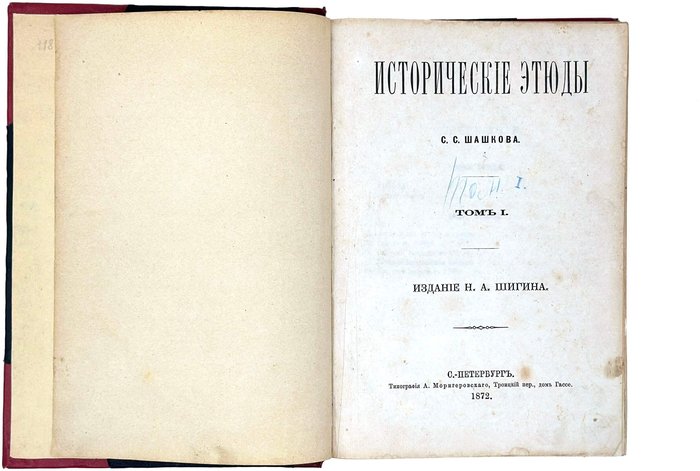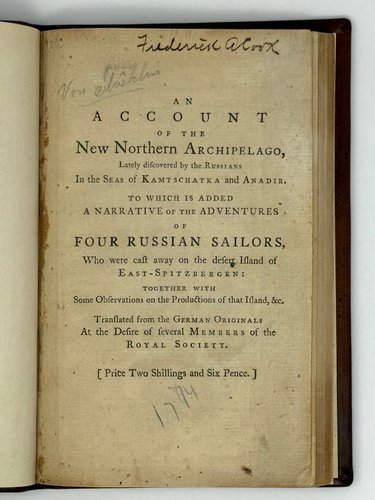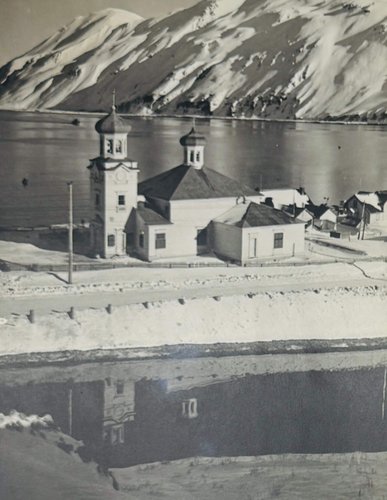







#RA21
1872
First edition. Large Octavo (ca. 23x15,5 cm). [2 – t.p.], [2 – table of contents], [2 - preface], 332; [2 – t.p.], 349 pp. Two volumes bound together. Title page to vol. 1 with a period blue pencil note “Tom [Vol.] 1.” Period gilt-tooled red quarter morocco with later black cloth boards and red cloth corners. Some minor age toning and water staining of text, but only at the top margin throughout the block, but overall a very good copy.
An important lesser-known Russian work on the history and modern state of the Russian American Company, related to the time of public discussion about the Company’s future in the early 1860s. This critical piece negatively characterizes RAC, concentrating on its suppression and abuse of the indigenous people from the Aleutian Islands, exploitation of Russian fur hunters (promyshlenniki), inefficient use of natural resources, unsuccessful trade in Alaska and California, &c., and follows the critical line started by famous Russian circumnavigator and explorer Vasily Golovnin in his “Notes of the current state of the Russian American Company, 1818” and “Notes about Kamchatka and Russian America in 1809, 1810 and 1811” (both first published in the “Materyaly dlya istorii Russkikh zaseleniy po beregam Vostochnogo Okeana,” as four supplements to the “Morskoy Sbornik” magazine in 1861). At the same time, the article remarks on RAC’s trade with California, fur hunting and export, relations with Aleuts and Tlingits, New Archangel and its facilities, government decrees in RAC’s support, &c.
The author was a noted oppositional Russian publicist and a supporter of the idea of Siberian separatism, Serafim Shashkov. Shashov graduated from the Kazan Theological Academy and the Eastern Faculty of Saint Petersburg University, in 1861-1862, and became a member of the so-called “Siberian group” in Saint Petersburg, led by Grigory Potanin and Nikolay Yadrintsev, who advocated for partial or complete independence of Siberia from the Russian state. Shashkov wrote over twenty articles on the topic, arguing that Siberia and the eastern frontiers of the Russian Empire were seen by Saint Petersburg authorities as colonies, and the natural and human resources of these lands were ruthlessly exploited. In Shashkov’s opinion, the most striking example of such exploitation was the activities of the Russian American Company. In 1865, Shashkov was arrested on the criminal case of the “Siberian group” and, in 1868-1873, was sentenced to exile in Arkhangelsk province. He continued his journalism work and wrote over 200 articles, published in the leading Russian magazines of the time (“Delo,” “Otechestvennye Zapiski,” “Zhivopisnoye Obozreniye,” “Sovremennoye Slovo,” &c.).
Shashkov’s article about the Russian American Company was first published in a rare Saint Petersburg newspaper, “Ocherki” (1863, issues 58-61). Being of liberal orientation, “Ocherki” existed for four months only (11 January – 8 April 1863) and closed after 94 issues. For the second time, the article was published in the “Istoricheskye etudy” in 1872 (vol. 2, pp. 295-330) with the edited ending. If the publication in the “Ocherki” dated back to 1863, when RAC’s fate was not decided yet, the article in the “Istoricheskye etudy” was issued five years after the sale of Alaska to the United States. At the end of the edited version, Shashkov noted: “Thus, the history of the Company clearly testifies that this organization only harmed the people, their trade, industry and welfare. The Company ruined its subjects and almost annihilated the entire Aleut population, and from a formerly abundant tribe of the Kuriltsy in 1862, there were only 66 people left alive <…>. [The administration system] was so insolvent that with all its misdeeds, it couldn’t provide enough profits even for the Company’s shareholders. And, despite that, the Company continued to exist until the government sold its lands to the United States. It became possible to talk about the harm inflicted by this monopoly only in the 1860s. Until then, the Russian public didn’t have the slightest idea about the shame Russians brought on themselves by their “feats” in the Eastern Ocean” (Istoricheskye Etudy, vol. 2, pp. 324-325).
For the third time, the article “Rossiysko-Amerikanskaya Kompaniya” was published without changes in Shashkov’s collected works in 1898 (Sobraniye Sochineniy: in 2 vols. Vol. 2. SPb.: O.N. Popova, 1898, pp. 632-651). After that, the article was not issued in Russian again. To our best knowledge, it was never translated into other languages.
During his work on the article, Shashkov evidently used Pyotr Tikhmenev’s fundamental “Istoricheskoe obozrenie obrazovaniia Rossiisko-Amerikanskoi kompanii i deistvii ieia do nastoiashchego vremeni” (SPb., 1861-63, 2 vols.) and the abovementioned articles by Vasily Golovnin, published as supplements to the “Morskoy Sbornik” magazine in 1861. In his publication, Shashkov briefly overviews the RAC’s history, aiming to show “what the Company did during more than 60 years of its existence. We don’t care what it achieved with its rights and privileges for itself; we’ll try to show what use it brought to the people, their trade and industries” (p. 300). He talks about the obligatory labour of Aleuts for the Company; compares the life of Aleuts, who were completely subdued by the Russian administration, with other indigenous people of Russian America, who continued to be independent; negatively remarks on the activity of Russian Orthodox missionaries (p. 307); calls Shelekhov a “proidokha” (“swindler”); describes the foundation of Fort Ross and its sale in 1841 (p. 314); the spread of smallpox and syphilis among the native population; mentions attempts of the administration to supply the colonies from mainland Russia, Sandwich Islands and the United States (p. 316); describes California as the main supplier of flour for the colonies (p. 316); Naplavkov-Popov’s coup against Baranov (1809) with the participants planning to go to the Ladrones or Mariana Islands (in fact, to Easter Island or “other southern Polynesian Islands,” p. 318); the latest attack by the natives on New Archangelsk in 1855; and finishes with a brief overview of Count Rezanov’s and Vasily Golovnin’s projects to establish self-administration of Russian colonies in America (p. 319). Apart from Golovnin’s articles, Shashkov quotes the travel accounts of Georg von Langsdorff (p. 304), Andrey Lazarev (p. 305), Adam von Krusenstern (p. 312) and Gavriil Davydov (p. 323).
Shortly after its first publication in the “Ocherki” newspaper, Shashkov’s article was heavily criticized in the conservative Saint Petersburg periodical “Severnaya Pchela,” published by Nikolay Grech. An article, signed by the pseudonym “Byvaly” (or an “Experienced one”), who had likely been to Russian America or was related to RAC, refuted Shashkov’s main statements and accused him of incompetency, bias and outright defamation (Byvaly. Po povodu statyi Shashkova “Rossiysko-Amerikanskaya Kompaniya”// Severnaya Pchela. 1863, No. 98, 15 April, pp. 395-396; No. 99, 16 April, pp. 399-400). Byvaly’s article was also published as an offprint the same year (Byvaly. Po povodu statyi Shashkova “Rossiysko-Amerikanskaya Kompaniya.” [SPb.]: Typ. of N. Grech, 1863. 56 pp.).
Overall, an important work about the importance and future of RAC not long before its sale to the United States.















